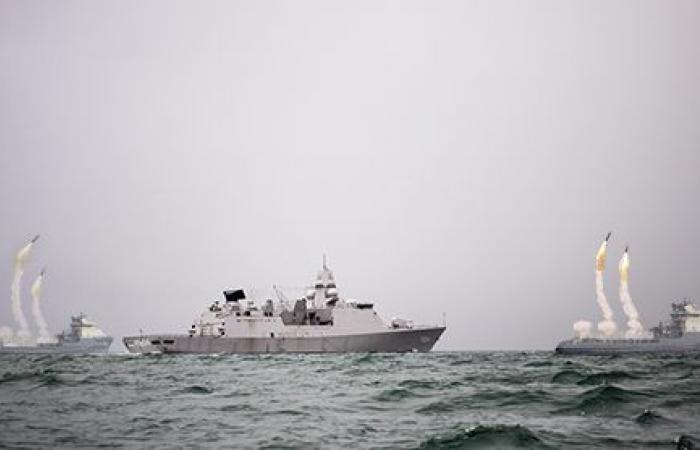Four large, low-manned ships, loaded with missiles. In the middle sails a frigate that can launch the missiles of these ships from a distance. In short, this is the idea that the Defense Materiel Organization (DMO) is working on for the navy and wants to test in the short term. The name: TRIFIC.
This is what it should look like in the future: a frigate surrounded by low-manned civil-built ships, which are equipped with missiles. The image above was fabricated by Marineschips.nl and is a sketch. No choice has yet been made for ships or weapon systems. (Photo and editing: Jaime Karremann/ Marineschips.nl)
“TRIFIC stands for The Rapidly Increased Firepower Capability Royal Netherlands Navy”, says Head of the Maritime Systems Department of DMO, KTZ Paul Flos.
Marineschips.nl recently visited this ‘blue’ department of DMO at the Kromhout barracks in Utrecht for an extensive interview with KTZ Flos. In this article we focus on TRIFIC, in the next piece we will take a closer look at the AMS department, ship design, Northern Naval Shipbuilding Cooperation and much more.
The navy urgently needs more combat power. New frigates are coming that have more modern and capable weapon systems than the current ships. Cruise missiles are also on the wish list, but they must be placed in existing launchers. The battle power of the frigates can be increased by installing more launchers, but it will be years before the new ships arrive.
“Looking at current threats, we just need those missiles,” says Flos. “When you see the number of missiles that are needed, at some point it doesn’t fit anymore. Not even in the design of FuAD [vervanger LCF, JK]A year ago, Flos and his Head of Abovewater Technology, Johan den Arend, came up with the idea of using large unmanned ships of about 60 or 70 meters in length to increase the navy’s effectiveness in the short term.
Flos: “While talking, we came up with a concept: a commercially available off-shore tender. You know them, a ship with a deckhouse at the front and then a very long deck. We completely fill that deck with missiles. ship has no other sensors apart from navigation radars, but gets its information and launch orders from the mothership: an LCF [Luchtverdedigings- en Commandofregat]an OPV [patrouilleschip] or other ship. And certainly the FuAD.”
“The assignment I gave Johan and his team in March is to investigate whether this is possible and how quickly we can get it. Speed is important, because we need it now,” says Flos. “We put that concept down in a big sketch. Johan traveled all over the world and wrote a neat report. It turned out that it is feasible. Part of that was also a TNO study into the best composition, which turned out to be a mother ship with to be four TRIFIC boats, which, by the way, remain within sight: about five miles [ruim negen kilometer, JK].”
Rockets
The ships are commercially available off the market, but the missiles, of course, are not. DMO has spoken with numerous providers in the past year. Flos: “You can put containers with a launcher on the deck of those ships. We have spoken with French, German, Israeli and American suppliers for the missiles and launchers. An extremely short delivery time is also a requirement: delivery date within a year. Really unique, but it is possible.”
“On a deck of a ship of 60 to 70 meters you can store about six containers with missiles. Eight missiles per container, times six. And there are even more if you put smaller missiles on it.”
The weapons that can be launched are diverse: air defense missiles, cruise missiles. Flos: “You can set up anything you want, including loitering ammunition, if you need to support marines.”
“There is also room for soft kill solutions with ECM [een soort stoorzender om bijvoorbeeld inkomende raketten te misleiden, JK], so that those four boats can also electronically pretend to be a large ship. If a missile comes our way, he already has to choose. Incidentally, the TRIFIC ships are protected by the mother ship, through the missiles they have on board.”
Placing only containers of weapons on the ships keeps the project “quick and cheap,” says Flos.
Radar data
The TRIFIC ships do not have their own sensors. “Only a navigation radar. However, crypto and a link for the fire control data to be sent to the missiles.”
The integration of this whole in the existing CMS (the software in the command center to fight with the frigate) is the biggest challenge, according to Flos. “Maritime IT says this is possible in the short term, that’s what we’re aiming for.”
“Those boats also talk to each other. Because it must also be determined which ship is going to fire; which ship is the most convenient for that and which ship can fire at that time.”
The monthly newsletter of Marineschips.nl
Read more about the content of the newsletter here
Not unmanned though
Although the plan was to have these ships sail completely unmanned, that turned out to be a bridge too far.
“Unmanned ships with weapons, that is still difficult. So now we stick to low manned surface vehicles: LMSV. The ships have a small crew of ten men per boat. And in the current concept there is always a man in the loop. Fire control data goes from the mother ship to the TRIFIC boat and then there is someone else to assess whether the boat is allowed to fire safely, he or she then presses the button.In theory, someone else can also agree, but there is always someone between,” says Flos.
“Eventually we will move to a low manned autonomous system. The third step is fully autonomous.”
To the Hague reality
“The plan is stated in the Defense memorandum as distributed action”, Flos continues. “Everywhere we present this concept, including at the CDS [Commandant der Strijdkrachten]people are convinced that we need this and that it is the right way to quickly increase the effectiveness.”
“We made a step-by-step plan. Start small and finish big. Think big, act small. What is the minimum concept we want and we want to test the concept,” says Flos. The project is now in the hands of the Planning Directorate, which falls under the CDS and is responsible for multi-year plans and requirements. In consultation with them, we are looking at how we are going to roll out this plan.
Please enable JavaScript to view the comments powered by Disqus.
comments powered by
Tags: Navy large heavily armed ships crew members short term
-





